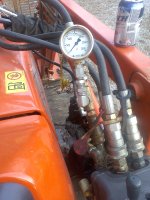I have seen no disagreement that flow should be limited to an amount such that the sickle is not a blur. High sickle speed is detrimental to the cut because material cannot get into the shear area well. ... And in the unlikely event something tuf did enter, the cutter stopping abruptly from high speed would see extreme forces. This would be from motor and blade inertia and have nothing to do with the relief pressure setting.
I said nothing about the sickle's teeth being a blur in my statement above.
You insist you're right about everything you state and that what the manufacturer states is in your vernacular total B.S. You're about the only Samuri user replying to my thread, and because of that you imply that your opinions are better than anything the manufacturer, or seemingly anyone else can offer.
As the thread OP I'd like something from you that isn't in the form of you know it all and anyone else's opinion, including the manufacturer is nutz. This is NOT helpful to me in determining what I should do to get the best use out of the new equipment I've purchased.
Have you spoken to the manufacturer, ever? I have on two occasions since I considered this sickle. Over the years they've made some improvements to the bucket bracket and other items I don't recall at this moment, but are likely in my notes about the sickle.
They say that in some applications for particular uses on certain tractors there may be a need for a flow restrictor or similar, but they are vague about what constitutes the necessary parameters.
It's obvious that the best cutting would occur with that item deepest into the space between the teeth. The teeth are serrated and not able to be sharpened.
Now, if you have something that will tell me succinctly, and without convolution, whether or not I should try running the sickle with or without any flow restrictor or similar device, then please enlighten me.

